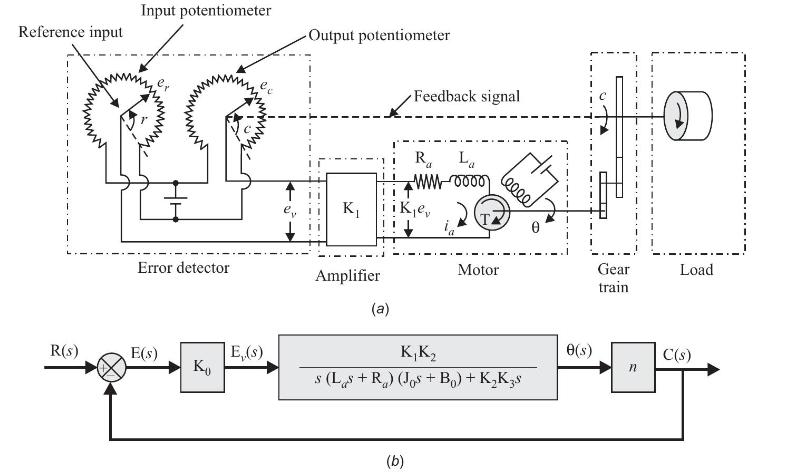A position control system is shown in Fig. D9.2(a). The angular position (boldsymbol{r}) is the reference input
Question:
A position control system is shown in Fig. D9.2(a). The angular position \(\boldsymbol{r}\) is the reference input to the system. The output shaft position determines the angular position \(\boldsymbol{c}\) of wiper arm of the output potentiometer. The error voltage \(e_{v}=e_{r}-e_{c}\) where \(e_{r}=\mathrm{K}_{0} . r\) and \(e_{c}=\mathrm{K}_{0} . c\) where \(\mathrm{K}_{0}\) is proportionality constant. \(\mathrm{K}_{1}\) is amplifier gain. The amplified output drives armature circuit of the DC motor. A fixed voltage is applied to field winding. The torque developed by motor is
\[
\begin{aligned}
& \mathrm{T}=\mathrm{K}_{2} i_{a} ; \mathrm{K}_{2}=\text { motor torque constant and } \\
& i_{a}=\text { armature current }
\end{aligned}
\]
\(\mathbf{K}_{3}\) is back emf constant. Gear ratio \(\boldsymbol{n}\) of gear train, is so chosen that \(\boldsymbol{c}=\boldsymbol{n} \boldsymbol{\theta}\). The overall system is designed to reduce error \(\boldsymbol{e}=\boldsymbol{r} \boldsymbol{\boldsymbol { c }}\) to zero if it exists. \(\mathrm{J}_{0}\) is the inertia of the motor plus load plus gear train referred to motor shaft. \(\mathrm{B}_{0}\) is viscous friction coefficient of motor plus load plus gear train referred to motor shaft. Show that system of Fig. D9.2(a) and block diagram shown in Fig. D9.2(b) are equivalent.
\[
\mathrm{L}_{a} \frac{d i_{a}}{d t}+\mathrm{R}_{a} i_{a}+\mathrm{K}_{3} \frac{d \theta}{d t}=\mathrm{K}_{1} e_{v}
\]
\[
\begin{aligned}
\mathrm{J}_{0} \frac{d^{2} \theta}{d t^{2}}+\mathrm{B}_{0} \frac{d \theta}{d t} & =\mathrm{T}=\mathrm{K}_{2} i_{a} \\
c & =n \theta
\end{aligned}
\]

Step by Step Answer:






